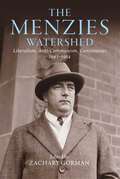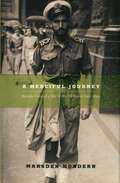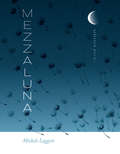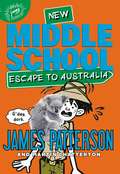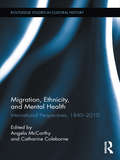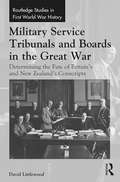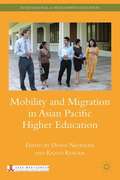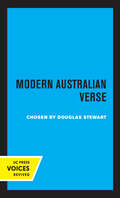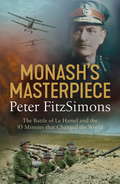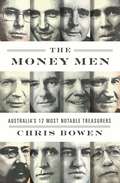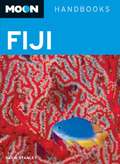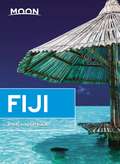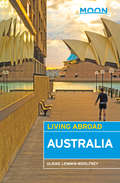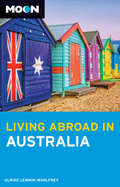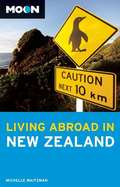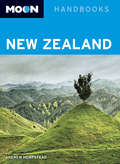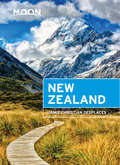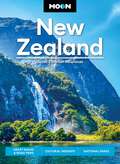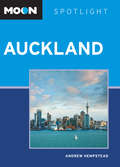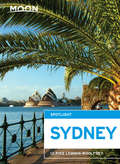- Table View
- List View
Menzies Watershed: Liberalism, Anti-communism, Continuities 1943–1954
by Zachary GormanThe eleven years that passed between the 1943 and the 1954 elections were arguably some of the most pivotal in Australian history. This was a period of intense political, policy and strategic transition, which saw a popular Labor Government and its state-led vision for post-war reconstruction toppled by Robert Menzies and his newly formed political machine, the Liberal Party of Australia. Meanwhile, a backdrop of rising Cold War tensions came to dominate domestic and international policymaking, ushering in a divisive communist party ban, the ANZUS treaty, the Colombo Plan, and Australia's own agency of international espionage, ASIS. But what was the difference in practical terms between Menzies and his predecessors? What role was the state to play under a centre-right government, and would Menzies be able to live up to the liberal ideals with which he had won over the Australian public? All these issues are explored in the second of a four-volume history of Menzies and his world, based on conferences convened by the Robert Menzies Institute at the University of Melbourne. Contributors include Christopher Beer, Andrew Blyth, Troy Bramston, Lorraine Finlay, Nicolle Flint, David Furse-Roberts, Anne Henderson, David Lee, Lucas McLennan, Lyndon Megarrity, Charles Richardson, William Stoltz and Tom Switzer.
Merciful Journey
by Marsden HordernIn 1939 Marsden Hordern's mother refused to sign the paper allowing her seventeen-year-old son to fight overseas with the Royal Australian Air Force. 'I did not rear you to be killed in an aeroplane,' she said. 'Join the navy.' He took her advice and in doing so determined his future. In small patrol boats, Fairmiles and a Harbour Defence Motor Launch, he patrolled the shores of Japanese-held territory, assisted beleaguered commandos in Timor, and was finally caught up in the drama of collecting Japanese prisoners of war from the islands. A Merciful Journey presents a vivid and compelling account of Hordern's life from a happy childhood growing up in Sydney during the Great Depression, to his years serving in the Royal Australian Navy from 1942 to 1947. Drawing on the letters and journals he wrote at the time, Hordern engagingly recounts his triumphs and disasters as a naval officer, detailing his rise from a young and callow sub-lieutenant to a lieutenant in command of his own ship. He recalls his hopes and fears, and, in the face of the horrors of war, reveals an appealing enthusiasm for new experiences and a growing love of the sea. A Merciful Journey is a delightful memoir of a young man's coming of age in wartime.
Mezzaluna: Selected Poems (Wesleyan Poetry Series)
by Michele LeggottMezzaluna gathers work from Michele Leggott's nine books of poetry. As reviewer David Eggleton writes: "Leggott shows us that the ordinary is full of marvels which... stitched, flow together into sequences and episodes that in turn form an ongoing serial, or bricolage: a single poem, then, rejecting exactness, literalism, naturalism in favor of resonance, currents, patterns of ebb and flow." In complex lyrics, sampling thought and song, voice and vision, Leggott creates lush textured soundscapes. Her poetry covers a wide range of topics rich in details of her New Zealand life, full of history and family, lights and mirrors, the real and the surreal. She focuses on appearance and disappearance as modes of memory, familial until we lose sight of that horizon line and must settle instead for a series of intersecting arcs. Leggott writes with tenderness and courage about the paradoxes of losing her sight and remaking the world in words.on white you fallinto lineher voice fillsthe groundpotato cuts the sundries paints the deck printsshapes shadows of oranges green 'cyan and magenta' sail your picnicsea into the eye land crimson lemons hand methe moonrisen rode rose ridewhite out to see
Middle School: Escape to Australia (Middle School #9)
by James Patterson Martin Chatterton Daniel GriffoIn the newest installment of James Patterson's bestselling Middle School series, everyone's favorite underdog hero Rafe Khatchadorian is headed to the dangerous wilds of Australia! Rafe isn't exactly considered a winner in Hills Village Middle School to say the least, but everything's about to change: he's won a school-wide art competition, and the fabulous prize is getting to jet-set off to Australia for a whirlwind adventure! But Rafe soon finds that living in the Land Down Under is harder than he could've ever imagined--his host-siblings are anything but welcoming, the burning temperatures are torturous, and poisonous critters are ready to sting or eat him at every step. So with the help of some new misfit friends, Rafe sets out to show everyone what he does best: create utter mayhem!
Migration, Ethnicity, and Mental Health: International Perspectives, 1840-2010 (Routledge Studies in Cultural History)
by Catharine Coleborne Angela McCarthyMost investigations of foreign-born migrants emphasize the successful adjustment and settlement of newcomers. Yet suicide, heavy drinking, violence, family separations, and domestic disharmony were but a few of the possible struggles experienced by those who relocated abroad in the nineteenth and twentieth centuries, and were among the chief reasons for committal to an asylum. Significant analysis of this problem, addressing the interconnected issues of migration, ethnicity, and insanity, has to date received little attention from the scholarly community. This international collection examines the difficulties that migrants faced in adjustment abroad, through a focus on migrants and mobile peoples, issues of ethnicity, and the impact of migration on the mental health of refugees. It further extends the migration paradigm beyond patients to incorporate the international exchange of medical ideas and institutional practices, and the recruitment of a medical workforce. These issues are explored through case studies which utilize different social and cultural historical methods, but with a shared twin purpose: to uncover the related histories of migration, ethnicity, and mental health, and to extend existing scholarly frameworks and findings in this under-developed field of inquiry.
Military Service Tribunals and Boards in the Great War: Determining the Fate of Britain’s and New Zealand’s Conscripts (Routledge Studies in First World War History)
by David LittlewoodWhile a plethora of studies have discussed why so many men decided to volunteer for the army during the Great War, the experiences of those who were called up under conscription have received relatively little scrutiny. Even when the implementation of the respective Military Service Acts has been investigated, scholars have usually focused on only the distinct minority of those eligible who expressed conscientious objections. It is rare to see equal significance placed on the fact that substantial numbers of men appealed, or were appealed for, on the grounds that their domestic, business, or occupational circumstances meant they should not be expected to serve. David Littlewood analyses the processes undergone by these men, and the workings of the bodies charged with assessing their cases, through a sustained transnational comparison of the British and New Zealand contexts.
Misery Guts
by Morris GleitzmanThe adventures of twelve-year-old Keith as he tries to cheer up his parents in many different ways include painting their shop in bright colors and convincing them to move from gloomy England to a place called Paradise.
Mobility And Migration In Asian Pacific Higher Education
by Deane E. Neubauer Kazuo KurodaThrough case studies in eight Asian countries, Europe, and the United States, this volume explores the range and consequences of increased mobility within Asia-Pacific higher education and the patterns of migration emerging for persons, ideas, institutions, and practices.
Modern Australian Verse: Modern Australian Verse (Poetry in Australia)
by Douglas StewartThis title is part of UC Press's Voices Revived program, which commemorates University of California Press’s mission to seek out and cultivate the brightest minds and give them voice, reach, and impact. Drawing on a backlist dating to 1893, Voices Revived makes high-quality, peer-reviewed scholarship accessible once again using print-on-demand technology. This title was originally published in 1965.
Modewarre: Home Ground
by Patricia SykesIn poems that are as concentrated as pearls, Patricia Sykes explores various histories--her own, those of her forebears, and the wider histories of identity and place. Citing the intersection of three distinct philosophies with particular birds--the indigenous modewarre, the colonial biziura lobata, and the common Wathaurong musk duck--these poems set out on the winding paths of memory and aspiration, searching for answers to the questions What is home? and What is identity? Their context is local and universal, their voices are restless and insistent, their themes are as broad or as narrowly defined as the journey demands. Whether inquiring into the futuristic interventions of intra-uterine surgery, the soft and hard arguments of living outside of the placenta, or into the dispossessions of terrorism, these poems seek to confront and understand the complex meanings of belonging. Two of the included poems have received acclaim: "Modewarre--ways you might approach it" was highly commended in the Josephine Ulrick Poetry Prize, and "Sanctuary: Swan Lake, Phillip Island" won the Tom Collins Poetry Prize.
Monash's Masterpiece: The battle of Le Hamel and the 93 minutes that changed the world
by Peter FitzSimonsThe Battle of Le Hamel on 4 July 1918 was an Allied triumph, and strategically very important in the closing stages of WW1. A largely Australian force commanded by the brilliant John Monash, fought what has described as the first modern battle - where infantry, tanks, artillery and planes operated together, as a coordinated force.Monash planned every detail meticulously - with nothing left to chance: integrated use of planes, wireless (and even carrier pigeons!)was the basis, and it went on from there, down to the details.Infantry, artillery, tanks and planes worked together of the battlefront, with relatively few losses. In the words of Monash: 'A perfect modern battle plan is like nothing so much as a score for an orchestral composition, where the various arms and units are the instruments, and the tasks they perform are their respective musical phrases.'
Money Men: Australia's Twelve Most Notable Treasurers
by Chris BowenHow much do we know about the second most important office in the nation? Who was Australia's first treasurer? Who resigned because of a relationship breakdown with the PM? And who did Frank Hardy base his character Ted Thurgood in Power without Glory on? The Money Men is the first in-depth look at the twelve most notable and interesting men to have held the office of Treasurer of Australia. Former Treasurer Chris Bowen brings a unique insider perspective to the lessons learned from the successes and failures of those who went before him. Who does Chris Bowen think has been Australia's most exceptional Treasurer? With revealing interviews of the five last treasurers, The Money Men dares to answer that question.
Moon Fiji
by David StanleySouth Pacific expert and veteran travel writer David Stanley knows the best way to experience Fiji, from making the most of one of the world's premiere diving spots to getting away from it all in lesser-known villages. David provides great trip ideas for a variety of travelers, such as Best of Fiji, Island-Hopper Special, and The Life Aquatic. Packed with information on swimming the reefs, taking day-long boat cruises, and sampling Fijian specialties, Moon Fiji gives travelers the tools they need to create a more personal and memorable experience.
Moon Fiji (Travel Guide)
by Minal HajratwalaExplore the colorful reefs, volcanic canyons, emerald rainforests, and unspoiled beaches of this sparkling archipelago with Moon Fiji. Inside you'll find:Flexible itineraries including four days on Taveuni Island, five days of island-hopping in the Yasawas, and the ten-day best of FijiStrategic advice for outdoor adventurers, diving enthusiasts, honeymooners, foodies, and more, with guidance on which island is right for youMust-see highlights and unique experiences: Go scuba-diving and spot barracuda, manta rays, and dolphins. Hike the rain-filled crater of a dormant volcano, raft down the thrilling Navua River, or zip-line through old-growth yesi forests. Share an intoxicating bowl of kava with new friends, tour an inland sugar plantation, or immerse yourself in the vibrant culture of indigenous peoples at a VOU dance performance. Sample fresh papaya, passionfruit, and mangoes from local growers or go off the grid in a traditional Fijian village, where you can practice mountainside yoga and learn to river fish with localsExpert insight: Minal Hajratwala, a writer with lifelong family ties to Fiji, recommends where to eat, how to get around, and where to stay, from guest cottages and beach bungalows to luxurious resortsFull-color photos and detailed maps throughoutReliable background information on the landscape, climate, wildlife, and history, as well as common customs, etiquette, and basic Fijian and Hindi phrasebooksHandy tips for families, seniors, students, and travelers with disabilities, plus ideas for traveling sustainably and engaging with the cultureWith Moon Fiji's practical tips and local know-how, you can experience the best of Fiji.Exploring the South Pacific? Check out Moon New Zealand.
Moon Living Abroad Australia (Living Abroad Ser.)
by Ulrike Lemmin-WoolfreyMake Your Move!If you've imagined yourself creating a new life abroad, but don't know where to start, Moon Living Abroad Australia has the honest and practical answers you need to make it happen. Experienced expat and Melbourne resident Ulrike Lemmin-Woolfrey knows a thing or two about adjusting to a new country.Moon Living Abroad Australia provides:Practical information on setting up the essentials, including visas, finances, employment, education, and healthcareStrategic advice on planning a fact-finding trip before making the moveEssential tips on how to find a place to live that fits your needs, whether you're a renter or a buyerA thorough survey of the best cities and regions to liveA deep exploration of the varying cultures, geography, climates, and wildlife of the vast and expansive continentInterviews with other expats who share their personal experiences building successful lives abroadSpecial tips for those with children or petsFirsthand insight from someone who's done it all Moon Living Abroad Australia provides honest advice and essential tools for anyone looking to make a new home abroad. Making a life-changing move has never been easier.
Moon Living Abroad New Zealand (Living Abroad)
by Michelle WaitzmanAuthor and educator Michelle Waitzman first visited New Zealand in 1998-and she's been hooked ever since. Now a New Zealand citizen, Waitzman outlines all the information you need to manage your move abroad in a smart, organized, and straightforward manner in Moon Living Abroad New Zealand. She offers straightforward tips and advice on how businesspeople, students, teachers, retirees, and professionals can make a smooth transition to living in a new culture and country.Moon Living Abroad New Zealand is packed with essential information and must-have details on setting up daily life, including obtaining visas, arranging finances, gaining employment, choosing schools, and finding health care, plus practical advice on how to rent or buy a home for a variety of needs and budgets. With extensive color and black and white photos, illustrations, and maps, Moon Living Abroad New Zealand will help you find your bearings as you settle into your new home and life abroad.
Moon Living Abroad in Australia
by Ulrike Lemmin-WoolfreyUlrike Lemmin-Woolfrey has lived in more than five countries, and her current residency in Australia has made her an expert at life "down under." Lemmin-Woolfrey provides insight and firsthand advice on making the move to Australia, and she outlines all the information needed in a smart, organized, and straightforward manner. Moon Living Abroad in Australia makes the moving and transition process easy for businesspeople, students, teachers, retirees, and professionals.Moon Living Abroad in Australia is packed with essential information and must-have details on setting up daily life, including obtaining visas, arranging finances, gaining employment, choosing schools, and finding health care. This relocation guide also includes practical advice on how to rent or buy a home for a variety of needs and budgets, whether it's an apartment in Sydney or a home across the continent in Perth.This ebook and its features are best experienced on iOS or Android devices and the Kindle Fire.
Moon Living Abroad in New Zealand
by Michelle WaitzmanMichelle Waltzman fell in love with New Zealand’s stunning landscapes and various outdoor activities on a backpacking trip in 1998, and has since moved to the country, recently obtaining permanent resident status. Michelle provides insight and first-hand advice on all that living in New Zealand has to offer. She outlines all the information needed in a smart, organized, and straightforward manner, making planning the move abroad manageable. Moon Living Abroad in New Zealandmakes the moving and transition process easy for businesspeople, students, teachers, retirees, and professionals. Moon Living Abroad in New Zealandis packed with essential information and must-have details on setting up daily life including obtaining visas, arranging finances, gaining employment, choosing schools, and finding health care. This relocation guide also includes practical advice on how to rent or buy a home for a variety of needs and budgets, whether it’s an apartment in cosmopolitan Wellington or a home in historic Christchurch. All Moon Living Abroad Guides include color photos, black and white photos, black and white illustrations, and maps.
Moon New Zealand
by Andrew HempsteadAustralia native, Andrew Hempstead, knows the best way to experience nearby New Zealand from kayaking through the Bay of Island and skiing in the Southern Alps to sampling a glass of vino at a local wine tasting. Andrew includes unique trip ideas such as Maori Culture and History and Tramping through New Zealand. Packed with information on dining, transportation, and accommodations, Moon New Zealand has lots of options for a range of travel budgets. Every Moon guidebook includes recommendations for must-see sights and many area, regional, and city-centred maps. Complete with details on enjoying the land with children, fine-dining in Auckland, and rafting near Queenstown, Moon New Zealand gives travellers the tools they need to create a more personal and memorable experience. With expert writers, first-rate strategic advice, and an essential dose of humour, Moon Handbooks are the cure for the common trip.
Moon New Zealand (Travel Guide)
by Jamie Christian DesplacesFrom green forests to blackened basalt, from snowy mountains to golden beaches, adventure awaits around every bend on these dramatic islands. Dive into Middle Earth with Moon New Zealand. Inside you'll find:Strategic itineraries including a week on both the North and South Islands, designed for hikers, cyclers, adrenaline junkies, history and culture buffs, and Lord of the Rings fansThe top spots for outdoor adventures, including surfing, bungy jumping, mountain biking, and trekking the Great Walks, as well as tips on how to do a New Zealand road tripThe top sights and unique experiences: Cruise the hypnotic black waters of the Milford Sound, spot wild dolphins, kiwis, and blue penguins, and explore the sprawling Waitomo Caves lit by twinkling glowworms. Go bungy jumping, paragliding, or jet skiing in Queensland, or soak in refreshing thermal pools. Embark on a multi-day trek to rugged coasts, glacial valleys, volcanoes, and fjords. Sample local sauvignon blancs in Marlborough and craft beers in Wellington, or sip cider in the Shire. Learn about Polynesian culture and history, marvel at Maori carvings, and savor a traditional hangiHow to experience New Zealand like an insider, support local and sustainable businesses, avoid crowds, and respectfully engage with the indigenous cultureExpert insight from Aukland local Jamie Christian Desplaces on when to go, how to get around, and where to stay Full-color photos and detailed maps throughout, plus a full-color detachable mapReliable background information on the landscape, climate, wildlife, and history, as well as common customs and etiquette Travel tips for seniors, families with children, visitors with disabilities, and LGBTQ travelersWith Moon New Zealand's expert advice and local insight, you can plan your trip your way.
Moon New Zealand (Travel Guide)
by Jamie Christian DesplacesFrom green forests to blackened basalt and snowy mountains to golden beaches, adventure awaits around every bend on these dramatic islands. Experience Middle Earth with Moon New Zealand. Inside you'll find:Strategic itineraries including a week on both the North and South Islands, designed for hikers, cyclists, adrenaline junkies, history and culture buffs, and Lord of the Rings fansThe top spots for outdoor adventures, like surfing, mountain biking, and trekking the Great Walks, as well as tips on how to do a New Zealand road trip. Go bungy jumping, paragliding, or jet skiing in Queensland, soak in refreshing thermal pools, or embark on a multi-day trek to rugged coasts, glacial valleys, volcanoes, and fjordsCan't-miss sights and unique experiences: Cruise the hypnotic black waters of the Milford Sound, spot wild dolphins, kiwis, and blue penguins, and explore the sprawling Waitomo Caves lit by twinkling glowworms. Sample local sauvignon blancs in Marlborough and craft beers in Wellington, or sip cider in the Shire. Learn about Polynesian culture and history, marvel at Maori carvings, and savor a traditional hangiHow to experience New Zealand like an insider, support local and sustainable businesses, avoid crowds, and respectfully engage with the indigenous culture, with expert insightfrom Aukland local Jamie Christian DesplacesFull-color photos and detailed maps throughout, plus a full-color detachable mapReliable background information on the landscape, climate, wildlife, and history, as well as common customs and etiquetteHelpful resources on COVID-19 and traveling to New ZealandTravel tips: When to go, how to get around, and where to stay, plus advice for seniors, families with children, visitors with disabilities, and LGBTQ+ travelersWith Moon's expert advice and local insight, you can experience the best of New Zealand. About Moon Travel Guides: Moon was founded in 1973 to empower independent, active, and conscious travel. We prioritize local businesses, outdoor recreation, and traveling strategically and sustainably. Moon Travel Guides are written by local, expert authors with great stories to tell—and they can't wait to share their favorite places with you.For more inspiration, follow @moonguides on social media.
Moon New Zealand: Great Walks & Road Trips, Cultural Insights, National Parks (Moon Asia & Pacific Travel Guide)
by Jamie Christian Desplaces Moon Travel GuidesFrom snowy mountains to golden beaches, beauty awaits around every bend on these dramatic islands. Find your adventure with Moon New Zealand. Inside you'll find:Strategic, flexible itineraries, including a trip to experience both the North and South Islands in 16 days The top spots for outdoor adventures, like surfing, mountain biking, and trekking the Great Walks, as well as tips for taking an epic road trip. Go bungee jumping or paragliding, soak in refreshing thermal pools, or embark on a multi-day trek to rugged coasts, glacial valleys, volcanoes, and fjords Can't-miss sights and unique experiences: Cruise the hypnotic black waters of the Milford Sound, spot wild dolphins, kiwis, and blue penguins, and explore the sprawling Waitomo Caves lit by twinkling glowworms. Sample local sauvignon blancs in Marlborough and craft beers in Wellington, or sip cider in the Shire. Learn about Polynesian culture and history, marvel at Māori carvings, and experience a traditional hangi meal How to experience New Zealand like an insider, support local and sustainable businesses, avoid crowds, and respectfully engage with indigenous culture, with expert insight from Auckland local Jamie Christian Desplaces Full-color photos and detailed maps throughout, plus a full-color detachable map Essential background information on the landscape, climate, wildlife, and history, as well as common customs and etiquette Travel tips: When to go, how to get around, and where to stay, plus advice for seniors, families with children, visitors with disabilities, and LGBTQ+ travelers Experience the best of New Zealand with Moon's expert advice and local insight. Visiting more of the South Pacific? Check out Moon Tahiti & French Polynesia.About Moon Travel Guides: Moon was founded in 1973 to empower independent, active, and conscious travel. We prioritize local businesses, outdoor recreation, and traveling strategically and sustainably. Moon Travel Guides are written by local, expert authors with great stories to tell—and they can't wait to share their favorite places with you. For more inspiration, follow @moonguides on social media.
Moon Spotlight Auckland
by Andrew HempsteadMoon Spotlight Auckland is an 115-page compact guide covering the best of New Zealand's most populous city. Experienced Australian travel writer Andrew Hempstead offers his firsthand advice on must-see attractions, as well as maps with sightseeing highlights, so you can make the most of your time. This lightweight guide is packed with recommendations on entertainment, shopping, recreation, accommodations, food, and transportation, making navigating this beautiful city - and its scenic surroundings - uncomplicated and enjoyable.
Moon Spotlight Sydney
by Ulrike Lemmin-WoolfreyMoon Spotlight Sydney is a full-color, 80-page compact guide covering the city of Sydney, as well as surrounding areas. Author Ulrike Lemmin-Woolfrey offers her seasoned advice on must-see attractions, and she includes maps with sightseeing highlights so you can make the most of your time. This lightweight guide is packed with recommendations on entertainment, shopping, recreation, accommodations, food, and transportation, making navigating this iconic city uncomplicated and enjoyable.This Spotlight guidebook is excerpted from Moon Sydney & the Great Barrier Reef.
Moon Sydney & the Great Barrier Reef (Moon Handbooks)
by Ulrike Lemmin-WoolfreyThis full-color guide to Sydney and the Great Barrier Reef includes vibrant photos and easy-to-use maps to help you plan the trip of a lifetime.The birthplace of modern Australia, Sydney is a bustling, cosmopolitan playground. Off Queensland's endless coast, the Great Barrier Reef is a playground of a different kind, a wonderland of coral gardens and colorful sea life. Larger than the Great Wall of China and home to thousands of species of wildlife, the Great Barrier Reef is an adventure-lover's paradise.In this book, expert traveler Ulrike Lemmin-Woolfrey tells you everything you need to know to make this trip possible, with tips on:How to get from Sydney to the Reef and where to stop along the way-including information on Cairns, Port Douglas, and TownsvilleHow to experience the Reef's world-class divingHow to choose the best reef cruises and rainforest toursHow to find and identify wildlifeand moreBackground on the diverse wildlife of the land and the sea-including how and where to see each species
